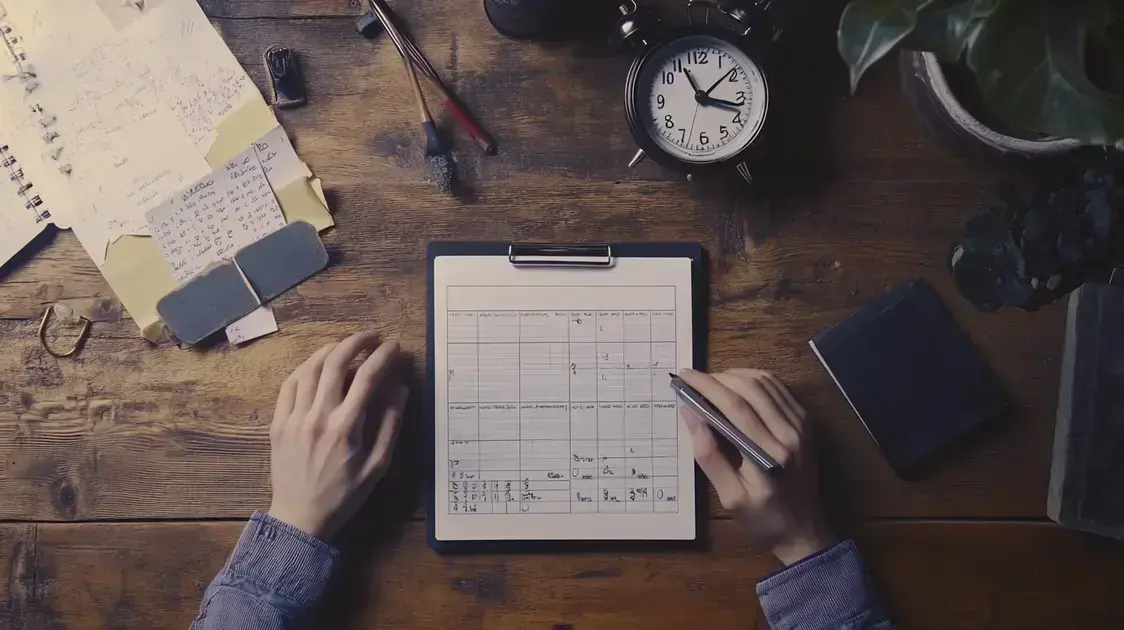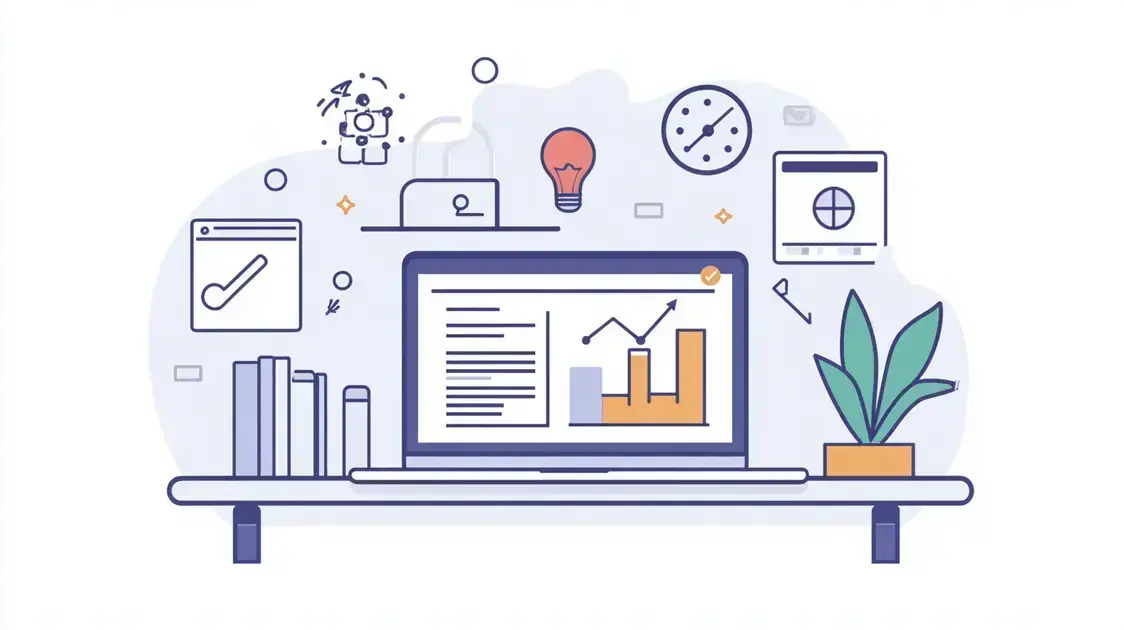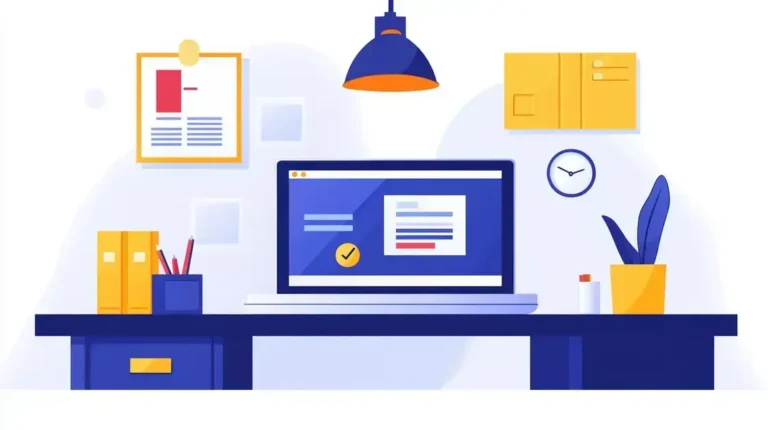Increase work efficiency by mastering time management, task prioritization, and optimizing your workspace. It’s about making small, strategic changes that can lead to better results.
Start by setting clear goals and sticking to them. When you prioritize tasks, you reduce distractions and enhance your focus, allowing you to achieve more in less time.
Another essential factor in how to increase work efficiency is continuous adaptation. Stay open to adjusting your approach and tools, so you can always work smarter, not harder.
Understanding Work Efficiency
Work efficiency is the ability to accomplish tasks effectively while making optimal use of available resources such as time, energy, and tools. It is not only about working harder but working smarter to achieve desired outcomes with minimal effort or waste.
The Key Elements of Work Efficiency
Efficiency begins with clearly defining goals and identifying priorities. When tasks are aligned with objectives, the chances of success improve markedly. Additionally, managing time wisely and eliminating unnecessary distractions are critical factors in ensuring steady progress.
Another important element is the use of well-thought-out workflows and processes. Structured approaches minimize confusion and reduce potential bottlenecks, allowing tasks to be completed more swiftly and accurately. Employing proven methodologies, like batching similar tasks or using the Pomodoro Technique, can dramatically increase work efficiency.
The Role of Self-Awareness
Understanding personal strengths and weaknesses is crucial for maintaining high levels of productivity. By recognizing when you’re most energetic or focused during the day, you can schedule demanding tasks accordingly. Self-awareness also helps identify areas for improvement, sparking the adoption of habits or tools that enhance work quality.
Beyond personal contributors, external factors such as team synergy and effective communication significantly impact efficiency levels. Establishing collaborative processes ensures clear expectations across team members, eliminating misunderstandings and delays.
Ultimately, consistently improving and maintaining efficiency requires a mindset of continuous learning and adaptation, making it possible to refine processes and tackle new challenges proactively. Increase work efficiency through this approach to work and personal development.
Benefits of Boosting Productivity
Boosting productivity has a direct and significant impact on both individual and organizational success. By achieving more in less time, you can open doors to opportunities for growth and innovation.
Improved Time Management
Higher productivity allows you to manage time effectively, leading to the completion of tasks without unnecessary delays. This enhances workflow consistency and ensures deadlines are met with ease.
Enhanced Work-Life Balance
With better productivity, tasks are accomplished faster, leaving more time for personal activities. This balance reduces stress and promotes overall well-being.
Increased Job Satisfaction
Completing tasks efficiently boosts morale and provides a sense of achievement. Employees feel more engaged when they see the results of their efforts, fostering a positive work environment.
Cost Efficiency
For businesses, elevated productivity reduces wasted resources, whether it’s time, materials, or financial investments. Operating costs ultimately decrease, providing more profitability.
Better Focus and Prioritization
When productivity increases, it becomes easier to prioritize tasks based on importance. This reduces distractions and ensures attention is focused on what matters most.
Adopting strategies to increase work efficiency can create long-term benefits for individuals and teams, empowering them to reach new levels of success.
Time Management Techniques for Efficiency

Effective time management is a cornerstone of improved efficiency, helping you allocate your hours toward tasks that yield the greatest impact. By prioritizing well and staying organized, work becomes more structured and productive.
The Pomodoro Technique
The Pomodoro Technique involves breaking your work into 25-minute focused intervals, followed by short breaks. This method maximizes attention spans and prevents burnout, making extended tasks more manageable.
Time Blocking
With time blocking, you assign specific periods on your calendar to particular tasks. This technique minimizes multitasking and ensures dedicated focus on your priorities. Tools like digital calendars or planners can streamline this practice.
The 80/20 Rule
Also known as the Pareto Principle, this approach involves focusing 80% of your efforts on the 20% of tasks that create the most value. By identifying these high-impact items, you can achieve more significant results in less time.
Task Batching
Task batching groups similar tasks together, such as answering emails or conducting research. Tackling them in one session reduces the inefficiency of context switching.
Daily Priority Setting
Each morning, write down the 3-5 most critical tasks you must complete for the day. Starting with the most important ensures that progress is made on key objectives, even if unexpected interruptions arise.
Incorporating these techniques to increase work efficiency makes it easier to manage demanding schedules, freeing up time for long-term goals and personal growth.
Effective Task Prioritization
Prioritizing tasks effectively is essential to focus your energy on what matters most and achieve greater productivity. When every effort aligns with key goals, both time and resources are optimized.
The Eisenhower Matrix
One of the most popular frameworks, the Eisenhower Matrix, helps categorize tasks into four quadrants: urgent and important, not urgent but important, urgent but not important, and neither urgent nor important. This tool assists in determining what requires immediate attention and what can be delegated or postponed.
Aligning with Objectives
To prioritize efficiently, always evaluate tasks based on their relevance to long-term goals. Activities that directly contribute to overarching objectives should take precedence over those with less impact.
Impact vs. Effort
Assessing the impact vs. the effort needed for a task is another effective method. High-impact activities that require minimal effort should be addressed first for the greatest results. Low-impact tasks can be deprioritized or scheduled later.
Setting Deadlines
Establishing clear deadlines for tasks adds structure to your workflow. Ensure realistic timelines based on the complexity of the task, and use reminders to keep progress on track.
Daily Task Review
At the end of each day, review your task list for the next day. Identify high-priority items and prepare accordingly. This habit ensures you start each day ready to tackle the most critical tasks.
Effective prioritization enhances decision-making, minimizes time wasted on low-value activities, and ensures consistent progress toward achieving your objectives. By focusing on the most important tasks, you can increase work efficiency and drive better results.
Work Environment Optimization
Optimizing your work environment is essential for enhancing focus, reducing stress, and improving overall productivity. A well-organized and thoughtfully designed workspace can make a significant difference in how efficiently tasks are completed. To increase work efficiency, making small changes in your surroundings can lead to big improvements.
Declutter Your Workspace
A clutter-free workspace helps eliminate distractions and creates room for clear thinking. Organize your desk by keeping only essential items within reach, and use storage solutions to maintain order.
Ergonomic Furnishings
Investing in ergonomic furniture not only enhances comfort but also reduces physical strain during extended work periods. Chairs with proper lumbar support and adjustable desks can help maintain good posture.
Lighting Matters
Proper lighting is crucial to prevent eye strain and create a more productive atmosphere. Use natural light whenever possible, supplemented with warm, adjustable artificial lighting to suit your needs.
Noise Control
Background noise can significantly impact concentration. Noise-canceling headphones, white noise machines, or creating a quiet work zone can help minimize distractions and keep focus intact.
Personalization
Adding personal touches to your workspace, such as photos, plants, or motivational notes, can create a welcoming and inspirational environment. Greenery, in particular, can boost mood and reduce stress.
Technology Organization
Ensure your tech setup is efficient by organizing cords, using docking stations, and arranging screens ergonomically. Regularly declutter your digital files to prevent frustration caused by slow systems or disorganization.
Optimizing the physical and mental elements of your work environment promotes productivity by supporting both comfort and increase work efficiency.
Technology Tools to Increase Efficiency

Leveraging technology tools can revolutionize the way tasks are completed, reducing efforts while increasing productivity. Integrating the right tools into daily operations helps streamline workflows and accomplish more in less time. To increase work efficiency, the right technology can make all the difference.
Task Management Software
Applications like Trello, Asana, or Monday.com allow you to organize tasks visually and track progress effortlessly. These tools facilitate collaboration by providing a centralized platform for assigning duties and setting deadlines.
Time Tracking Tools
Time tracking apps such as Toggl and Clockify help you monitor how long you spend on specific tasks. This data can highlight inefficiencies, enabling you to adjust workflows and focus on priorities.
Automation Tools
Tools like Zapier and IFTTT connect your apps to automate repetitive tasks. From scheduling emails to organizing files, automation frees up your time for more high-level activities.
Communication Platforms
Platforms like Slack and Microsoft Teams improve team communication. They centralize messaging, file sharing, and meetings, ensuring teams stay aligned and collaborate efficiently.
Cloud-Based Storage
Services like Google Drive and Dropbox make document sharing and storage seamless. Cloud integration allows teams to access files instantly from anywhere, promoting remote work flexibility and collaboration.
Productivity Extensions
Browser extensions such as Grammarly or StayFocusd can enhance writing accuracy or limit distractions online. These tools boost individual efficiency when working on detailed tasks.
By adopting these digital solutions, you can optimize productivity on both personal and team levels, unlocking new opportunities for growth and success, ultimately helping you increase work efficiency.
Overcoming Procrastination
Procrastination is one of the biggest barriers to productivity. Understanding and tackling its root causes can help you stay on track and accomplish your goals efficiently. To increase work efficiency, addressing procrastination is a key step in improving your workflow.
Break Tasks Into Smaller Steps
Large tasks often feel overwhelming, leading to delays. Divide them into smaller, manageable pieces. Completing small steps builds momentum, making the overall task easier to finish.
Set Realistic Deadlines
Unstructured time can encourage procrastination. By setting specific and achievable deadlines, you’re more likely to stay focused and avoid unnecessary delays. Use reminders or alarms to help enforce these timelines.
Avoid Distractions
Eliminate distractions like social media, unnecessary notifications, or clutter in your workspace. Designate specific periods for focused work where distractions are minimized.
Use the Two-Minute Rule
If a task takes less than two minutes to complete, do it immediately. This rule eliminates small pending items and clears mental space, reducing procrastination triggers.
Reward Progress
Incorporate rewards as part of your work process. Completing a task or milestone gives you a sense of accomplishment, providing motivation to keep going.
Identify Triggers
Take time to analyze why you procrastinate. Whether it’s fear of failure, distraction, or the feeling of being unprepared, addressing the root cause ensures you develop habits to counteract these tendencies effectively.
With the right strategies and a commitment to consistency, overcoming procrastination becomes a practical and achievable goal, helping you increase work efficiency.
Building Productive Daily Habits
Building productive daily habits is essential for maintaining consistency and achieving long-term success. Small, repeatable actions can help develop discipline and significantly improve work efficiency over time. To increase work efficiency, these habits can create a powerful foundation for your productivity.
Start with a Morning Routine
Establish a structured morning routine to set a positive tone for the day. Activities like exercise, journaling, or planning your tasks can boost energy and mental clarity.
Focus on One Task at a Time
Multitasking often reduces productivity. Train yourself to concentrate on one task at a time to improve quality and complete tasks faster.
Use Daily Planning Tools
Incorporate planners, to-do lists, or digital task management apps into your routine. Planning ahead minimizes uncertainty, helping you stay organized and avoid overlooked responsibilities.
Take Regular Breaks
Scheduled breaks, like following the 25-minute Pomodoro cycle, recharge your brain while preventing burnout. Use small breaks for activities like stretching or meditating.
End the Day With Reflection
Review your accomplishments at the end of each day. Reflecting on your progress reinforces positive habits and encourages adjustments to unproductive behaviors when needed.
Consistency Over Perfection
Commit to small, sustainable changes to build habits gradually. Perfection is less important than consistency; sticking to your routine strengthens behaviors that support efficiency.
By making these practices part of your daily life, you create a strong foundation for focused, efficient work that drives meaningful results, ultimately helping you increase work efficiency.
Collaboration Tips for Better Team Efficiency

Collaboration is essential for improving team efficiency and ensuring smooth workflows. Strong communication and effective strategies play a critical role in achieving collective goals successfully.
Establish Clear Roles and Responsibilities
Clearly outline each team member’s responsibilities to avoid confusion. This ensures everyone knows their contributions and reduces duplicated efforts.
Use Collaboration Tools
Leverage tools like Slack, Microsoft Teams, or Trello to centralize communication and manage projects. These platforms streamline discussions, document sharing, and task tracking across teams.
Schedule Regular Check-Ins
Frequent team meetings help sync progress and address roadblocks. Regular check-ins keep everyone aligned and create opportunities to share updates, ideas, or concerns.
Adopt Active Listening
Encourage team members to practice active listening during interactions. Acknowledging and considering each viewpoint fosters mutual understanding and strengthens overall teamwork.
Encourage Open Feedback
Create a culture where constructive feedback is welcomed. Sharing observations positively and constructively promotes constant improvement and boosts trust among members.
Promote Team-Building Activities
Organizing team-building exercises strengthens relationships. Building trust and rapport outside of work tasks leads to better collaboration and communication during projects.
Set Shared Goals
Align the team toward common objectives by ensuring everyone understands the ultimate goals. Shared goals foster unity and encourage all members to contribute equally.
Implementing these collaborative strategies helps teams operate efficiently, improve productivity, and achieve collective success.
FAQ – Frequently Asked Questions About Increasing Work Efficiency
What are some effective time management techniques?
Techniques like the Pomodoro Technique, time blocking, and daily priority setting can help structure your workflow and reduce wasted time.
How can I prioritize tasks to improve productivity?
Using methods like the Eisenhower Matrix or the 80/20 rule allows you to focus on high-impact tasks while delegating less important ones.
What tech tools can improve work efficiency?
Tools such as Trello, Slack, Toggl, and Zapier can streamline task management, communication, and automate repetitive processes.
How can I overcome procrastination during work?
Breaking tasks into smaller steps, setting realistic deadlines, and using techniques like the two-minute rule can help combat procrastination effectively.
What are the benefits of building productive daily habits?
Productive daily habits improve focus, consistency, and overall efficiency. Examples include establishing a morning routine and reflecting on daily achievements.
How can I optimize my work environment for better productivity?
Declutter your space, prioritize ergonomic furniture, use proper lighting, and reduce noise distractions to create a more efficient environment.
